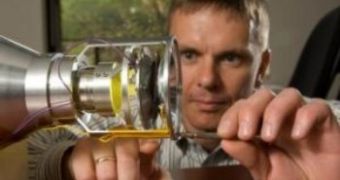When cruising in your car, a police laser radar can easily measure your speed and send the ticket to your door, probably along with a picture showing your big grin at 160 km/h (100 mph). But when it comes to observing particles traveling at 1/3 the speed of light - 100,000 km/s - things get a bit complicated.
Even the most modern lasers are having difficulties in making highly precise in-flight distance measurements on the nanoscale. A new one, developed by an international collaboration at the Michigan State University National Superconducting Cyclotron Laboratory, led by assistant professor Krzysztof Starosta, can do just that.
It can accurately measure particles like heavy nuclei from rare isotopes, which usually travel too fast to be recorded by regular instruments. The team was successful in measuring an excited state of germanium-64, Ge-64, by looking at how much time it needed to decay into lower energy state.
This new method can effectively characterize the shape and structure of some of the most exotic nuclei, like the ones of the element germanium, whose stable form Ge-73 is very common on Earth and mostly used as a semiconductor in the computing industry.
The unstable isotopes, however, are the most difficult to analyze, and this is only the second time an effective technique of lifetime measurement was experimentally demonstrated in the strange part of the nuclear universe where unusual proton-neutron ratios cause some really strange behaviors.
"It's opening up a whole range of possible studies," said Roderick Clark, a physicist and co-leader of the nuclear structure group at Lawrence Berkeley National Laboratory, who was not involved in the experiment. "That's as far as you can go, the frontiers of this research. This is one of the areas that NSCL is leading the world in."

 14 DAY TRIAL //
14 DAY TRIAL //